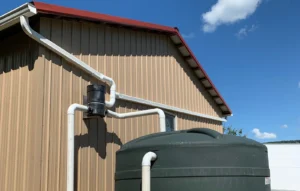Rainwater Harvesting System : An Eco-Friendly Solution for Contemporary Construction

With the onset of sustainable development and a growing environmental awareness, Rainwater Harvesting in MEP Construction have proven to be a key element in both residential and commercial building construction. Not only do rainwater harvesting systems provide the benefit of water conservation but also minimize reliance on municipal water supplies. For MEP construction professionals and MEP service providers, it is important to comprehend the incorporation of rainwater harvesting into mechanical, electrical, and plumbing (MEP) systems.
What is Rainwater Harvesting?
Rainwater Harvesting in MEP Construction refers to the collection and accumulation of rainwater from surfaces such as rooftops, terraces, and open grounds for utilization in the future. The water can be utilized for non-potable applications such as irrigation, flushing, and landscaping, and in certain applications, it can be treated for potable application.
Role in Modern Engineering
The function of MEP in engineering now goes beyond conventional construction work. As sustainability takes center stage, the inclusion of rainwater harvesting in MEP civil engineering projects means effective water management, minimization of environmental footprints, and aiding in green building certifications.
Elements of a Rainwater Harvesting System
A conventional rainwater harvesting system is made up of:
Catchment Area – The location (typically a roof) where rain descends.
Downspouts and Gutters – They guide water from the catchment area to the storage system.
First Flush Diverter – Prevents trash and pollutants from entering the water that is stored in tanks.
Storage Tanks – Store and hold the collected water.
Filtration and Treatment Units – These may be added but are advisable when the water is intended for human consumption.
Role of MEP Services
Including rainwater collection in building designs entails coordination among mechanical, electrical & plumbing (MEP) systems. Here’s how:
Mechanical : Pump design, storage tank design, and pipeline design to optimize water passage.
Electrical : Designing control systems, sensors, and automatic pumps for distributing water.
Plumbing : Optimal pipe sizing, filtration units, and interface with the existing water supply system.
By involving MEP experts early in the project, developers can ensure that Rainwater Harvesting in MEP Construction are efficient, cost-effective, and aligned with building codes.
Benefits of Rainwater Harvesting in MEP Civil Engineering Projects
Water Conservation – Reduces dependency on municipal water systems.
Cost Savings – Decreases water bills and operational costs.
Environmental Impact – Helps prevent flooding, groundwater depletion, and soil erosion.
Sustainability Certifications – Assists LEED, IGBC, and other green building ratings.
Integration with MEP Services – Smooth coordination with plumbing, electrical, and mechanical systems provides optimized performance.
Challenge and Solutions
Introducing a rainwater harvesting system to MEP construction projects may encounter issues such as:
Space Constraints : Modulus tanks or underground storage tanks can be installed in restricted spaces.
Maintenance Issues : Periodic cleaning of tanks, filters, and gutters ensures longevity.
Quality Issues : Effective treatment and filtration processes avoid contamination and provide safe consumption in Rainwater Harvesting in MEP Construction.
Conclusion
Rainwater harvesting is not merely an eco-friendly movement now; it is a strategic element in MEP in MEP civil engineering and engineering projects. By incorporating MEP services effectively, construction experts can design sustainable buildings that save water, minimize expenditure, and enhance green living.
For contemporary MEP building, adopting rainwater harvesting is not just clever engineering—it’s a duty towards the future that is sustainable.


